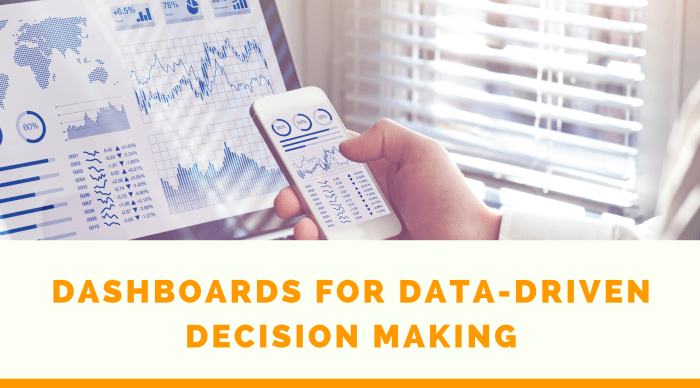Dashboards for decision makers are powerful tools that provide invaluable insights for strategic decision-making. This article delves into the importance of dashboards and how they can revolutionize the way decisions are made in various industries.
From visualizing key metrics to customizing dashboards for different stakeholders, this comprehensive guide will explore all aspects of creating effective dashboards for decision makers.
Importance of Dashboards for Decision Makers

Dashboards play a crucial role in aiding decision-makers by providing a visual representation of complex data and information. Decision makers can quickly analyze and interpret data to make informed decisions in a timely manner.
Providing Valuable Insights
Dashboards can provide valuable insights to decision makers by consolidating data from various sources into a single, easy-to-understand interface. For example, a sales dashboard can show real-time sales performance, trends, and forecasts, enabling decision makers to identify opportunities for growth or areas that need improvement.
Monitoring Key Performance Indicators (KPIs)
Dashboards help in monitoring key performance indicators (KPIs) by displaying KPI metrics in a visual format. Decision makers can track progress towards goals, identify deviations, and take corrective actions promptly. For instance, a marketing dashboard can show KPIs like website traffic, conversion rates, and social media engagement, allowing decision makers to optimize marketing strategies for better results.
Designing Effective Dashboards: Dashboards For Decision Makers

Creating visually appealing dashboards is essential for engaging decision makers and ensuring the data is easily digestible. Here are some tips for designing effective dashboards:
Importance of Data Visualization Techniques
Utilizing data visualization techniques is crucial in dashboard design as it helps in presenting complex data in a clear and concise manner. Some best practices include:
- Use charts, graphs, and heat maps to represent data visually.
- Choose the right type of visualization for the data being presented.
- Ensure color schemes are consistent and meaningful to avoid confusion.
- Highlight key metrics or trends using visual elements like color or size.
Best Practices for Organizing Data on Dashboards
Organizing data effectively on dashboards is crucial for easy interpretation and decision-making. Some best practices include:
- Group related data together to provide context and make connections more apparent.
- Utilize whitespace to separate different sections and improve readability.
- Prioritize the most important data and avoid cluttering the dashboard with unnecessary information.
- Provide interactive elements like filters or drill-down options for users to explore the data in more detail.
Key Metrics to Include in Dashboards

When designing dashboards for decision makers, it is crucial to identify the key metrics that will provide valuable insights and aid in informed decision-making. These metrics should be carefully selected to ensure that they align with the strategic goals of the organization and help drive performance.
Essential Metrics for Decision Makers
- Sales Performance: Tracking sales figures, trends, and forecasts can help decision makers understand the revenue generated and identify areas for improvement.
- Financial Health: Metrics like cash flow, profit margins, and return on investment provide a comprehensive view of the financial stability and profitability of the organization.
- Customer Satisfaction: Monitoring customer feedback, retention rates, and Net Promoter Score (NPS) can help decision makers gauge the level of customer satisfaction and loyalty.
- Operational Efficiency: Metrics related to production output, resource utilization, and supply chain performance can highlight operational strengths and weaknesses.
Prioritizing Metrics on Dashboards
When deciding which metrics to display on the dashboard, it is essential to prioritize those that directly impact the strategic objectives of the organization. High-priority metrics should be easily accessible and prominently displayed to ensure quick decision-making.
Significance of Real-Time Data Updates
Real-time data updates play a crucial role in decision-making dashboards by providing decision makers with the most current information to make informed choices. Timely updates enable quick responses to changing market conditions, emerging trends, and unforeseen challenges, allowing organizations to stay agile and competitive.
Customizing Dashboards for Different Stakeholders
Customizing dashboards for different stakeholders is crucial to ensure that each user gets the relevant information they need to make informed decisions. By tailoring dashboards to meet the specific needs of various stakeholders, organizations can enhance user experience and drive better outcomes.
Benefits of Customization
- Personalized Insights: Customizing dashboards allows stakeholders to focus on the key metrics and data points that are most relevant to their role or objectives.
- Improved Decision-Making: Tailored dashboards provide stakeholders with actionable insights that align with their specific responsibilities, leading to more informed decisions.
- Enhanced User Experience: Customization enhances the usability of dashboards, making it easier for stakeholders to navigate and interpret the data effectively.
Examples of Customization, Dashboards for decision makers
- Executive Dashboard: Executives may require high-level summaries and KPIs to track overall performance and strategic goals.
- Marketing Dashboard: Marketing teams may need detailed metrics on campaign performance, customer engagement, and ROI.
- Sales Dashboard: Sales teams may benefit from real-time data on leads, pipeline status, and revenue targets.
Importance of User Feedback
User feedback plays a critical role in refining and customizing dashboards to meet the evolving needs of stakeholders. By actively soliciting feedback and incorporating user suggestions, organizations can ensure that dashboards remain relevant, user-friendly, and effective in driving decision-making processes.
In conclusion, dashboards for decision makers play a crucial role in facilitating informed and data-driven decisions. By implementing the best practices discussed in this article, organizations can optimize their decision-making processes and achieve greater success.
When it comes to upgrading your technology infrastructure, data migration services play a crucial role in ensuring a smooth transition. With the right expertise and tools, your business can securely transfer data to new systems without any disruptions.
Implementing big data analytics solutions can revolutionize the way your company processes information. By harnessing the power of advanced analytics, you can gain valuable insights that drive strategic decision-making and improve overall performance.
Utilizing text mining for data analysis can help extract valuable information from unstructured data sources. By employing natural language processing techniques, businesses can uncover hidden patterns and trends to make informed decisions.

